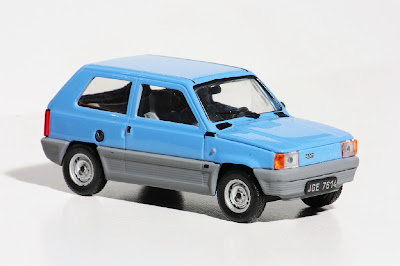Tuesday 22 January 2013
Introduced in 1980, the Panda (Type 141) was designed as a modern day "peasant car": a cheap, basic, no-frills utility vehicle, that would be easy to use and maintain. It can be seen as a later approach to the same niche which the Citroën 2CV and Renault 4 were designed to serve. Designed by Giorgetto Giugiaro, the Panda was noted for its box-like styling, which would become the house style for Fiats throughout the 1980s.
Mechanically the first Pandas borrowed heavily from the Fiat parts bin. Engines and transmissions came from the Fiat 127 and, in certain territories, the air-cooled 652 cc two-cylinder powerplant from the Fiat 126. The plan for a mechanically simple car was also evident in the rear suspension, which used a dead axle suspended on leaf springs. Later versions of the car added various mechanical improvements but this spirit of robust simplicity was adhered to throughout the life of the model.
Many design features reflect the Panda's utilitarian practicality. Examples include a seven-position adjustable rear seat which could be folded flat to make an improvised bed, or folded into a V shape to support awkward loads, or easily and quickly removed altogether to increase the overall load space. The first Pandas also featured removable, washable seat covers, door trims and dashboard cover, and all the glass panels were flat making them cheap to produce, easy to replace and interchangeable between left and right door. Much like its earlier French counterparts the Panda could be specified with a two piece roll forward canvas roof.
The original Panda met with great success across Europe, polling 2nd in the 1981 European Car of the Year awards in its first full year of production (pipped to first place by the Ford Escort Mark III) and staying in production in some regions until May 2003.
The first Pandas came fitted with either a two-cylinder air-cooled 652 cc engine (derived from that of the 126) — the Panda 30; or a four-cylinder water-cooled engine displacing 903 cc (from the 127) — the Panda 45. In September 1982 Fiat added another engine to the line-up: the Panda 34 used an 843 cc water-cooled unit, derived from that in the 850. It was originally reserved for export to France, Belgium, Germany, and the Netherlands.
Fiat launched the Panda 45 Super at the Paris Motorshow later in 1982, with previous specification models continuing as the "Comfort" trim. The Super offered numerous improvements, most significant being the availability of a five-speed gearbox as well as improved trim. There were minor styling changes to the Super including the introduction of Fiat's new black plastic "corporate" grille with five diagonal silver bars. The earlier grille design (metal with slots on the left for ventilation) continued on the Comfort models until the next major revision of the line-up. A 30 Super was added to the range in February 1983, offering the Super trim combined with the smaller engine.
The Panda 4x4 was launched in June 1983, it was powered by a 965 cc engine with 48 bhp (36 kW) derived from that in the Autobianchi A112. Known simply as the Panda 4x4, this model was the first small, transverse-engined production car to have a 4WD system. The system itself was manually selectable, with an ultra-low first gear. Under normal (on-road) conditions starting was from second, with the fifth gear having the same ratio as fourth in the normal Panda. Austrian company Steyr-Puch supplied the entire drivetrain (clutch, gearbox, power take-off, three-piece propshaft, rear axle including differential and brakes) to the plant at Termini Imerese where it was fitted to the reinforced bodyshell.
Minor revisions in November 1984 saw the range renamed "L", "CL", and "S". Specifications and detailing were modified across the range including the adoption of the Fiat corporate grille across all versions. Mechanically, however, the cars remained largely unchanged.
Technical data:
- engine: 4 cylinders
- capacity: 999 cc
- horsepower: 45 HP
- gearbox: 4+1
- top speed: 145 km/h











Brak komentarzy:
Prześlij komentarz